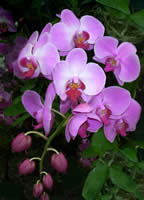
Dimdima
Online Children's Magazine from India

Dimdima
Online Children's Magazine from India
By Rani Iyer

Did you know that all orchids are endangered? Orchids are unusual flowers that have captured the attention of humans, or stirred their passions. Since the beginning of our knowledge of botany, all orchids, about 20,000 wild varieties have been systematically collected and hunted. Adventurers often died during daring collection ventures in swamps and forests. And gardeners toiled for centuries to perfect the technique of coaxing an orchid to grow and flower in the greenhouse.
As if a pretty face is not enough, orchids also have interesting relationships with their symbiotic partners and pollinators. Orchid seeds germinate only when a special type of fungus, which does not harm the plant, infects them. Consider the case of the bee orchid, in the island of Majorca.
 The bee orchid blossoms look and smell just like honey and lure the male bees to visit them. The bee mistakes the flowers for their mate and repeatedly visits them. The plant has tricked the bees to carry pollen sacs, pollinia, from one flower to another! The bucket orchid lures male bees with perfumed oil that the bees need to attract mates. Some orchids have tortuous traps; others attract flies by smelling like dead meat! Orchids pollinated by butterflies look like flowers that offer nectar-rich rewards. These unique interactions between pollinators and orchids are called co-evolution.
The bee orchid blossoms look and smell just like honey and lure the male bees to visit them. The bee mistakes the flowers for their mate and repeatedly visits them. The plant has tricked the bees to carry pollen sacs, pollinia, from one flower to another! The bucket orchid lures male bees with perfumed oil that the bees need to attract mates. Some orchids have tortuous traps; others attract flies by smelling like dead meat! Orchids pollinated by butterflies look like flowers that offer nectar-rich rewards. These unique interactions between pollinators and orchids are called co-evolution.
Orchid lovers from all over the world gather for an annual International Orchid Show, where thousands of fans gather and wait eagerly for the verdict on the showiest flowers created by orchid breeders. Human breeders have created many more types of hybrid orchids than nature. They take pride in watching their plant grow from seed, and wait for several long years until it blooms! Orchids can be grown indoors, and in all climates. Because of this, orchids are in demand throughout the world. Next time you see an orchid, try not to fall under its spell!
Last updated on :3/26/2004
EXPLORE MORE...
COMMENT ON THIS ARTICLE
Wants to share something related to this article? Please use the form below.
Dimdima is the Sanskrit word for ‘drumbeat’. In olden days, victory in battle was heralded by the beat of drums or any important news to be conveyed to the people used to be accompanied with drumbeats.
Bharatiya Vidya Bhavan
K. M Munshi Marg,
Chowpatty, Mumbai - 400 007
email : editor@dimdima.com
Bharatiya Vidya Bhavan
505, Sane Guruji Marg,
Tardeo, Mumbai - 400 034
email : promo@dimdima.com
Dimdima.com, the Children's Website of Bharatiya Vidya Bhavan launched in 2000 and came out with a Printed version of Dimdima Magazine in 2004. At present the Printed Version have more than 35,000 subscribers from India and Abroad.